 | ||
Similar Areca nut, Mukhwas, Gulkand, Catechu, Kulfi | ||
The making of meetha paan
Paan (Hindi: पान, Urdu: پان, Bengali: পান from Sanskrit parṇa, "পর্ণ" "leaf") is a preparation combining betel leaf with areca nut and sometimes also with tobacco. It is chewed for its stimulant and psychoactive effects. After chewing it is either spat out or swallowed. Paan has many variations. Slaked lime (chunnam) paste is commonly added to bind the leaves. Some South Asian preparations include katha paste or mukhwas to freshen the breath.
Contents
- The making of meetha paan
- Chuski paan
- Effects on health
- Effects of chewing paan during pregnancy
- Culture
- India
- Indonesia and Malaysia
- Philippines
- Myanmar
- Pakistan
- Cambodia Laos and Thailand
- Vietnam
- Bangladesh
- Nepal
- Taiwan
- References
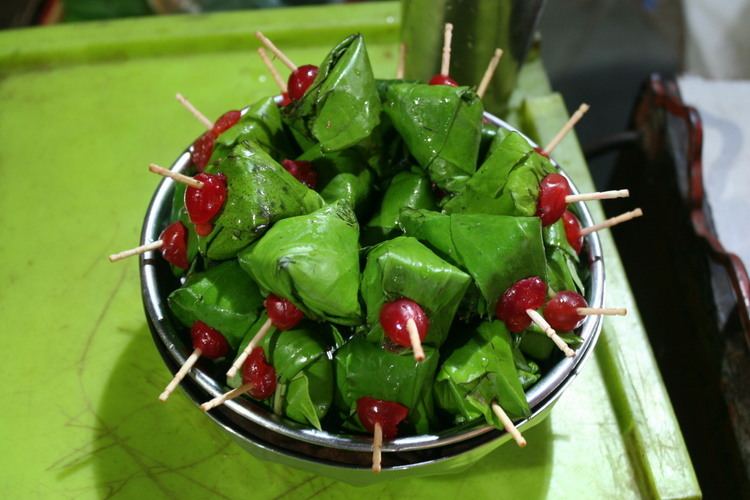
The origin and diffusion of paan (betel chewing) remains a somewhat unresolved issue since there is little unequivocal evidence to support the very early dates often quoted, though botanical evidence strongly suggests that the areca palm was not native to South Asia. Paan (under a variety of names) is also consumed in many other Asian countries and elsewhere in the world by some Asian emigrants, with or without tobacco. It is an addictive and euphoria-inducing formulation with adverse health effects.
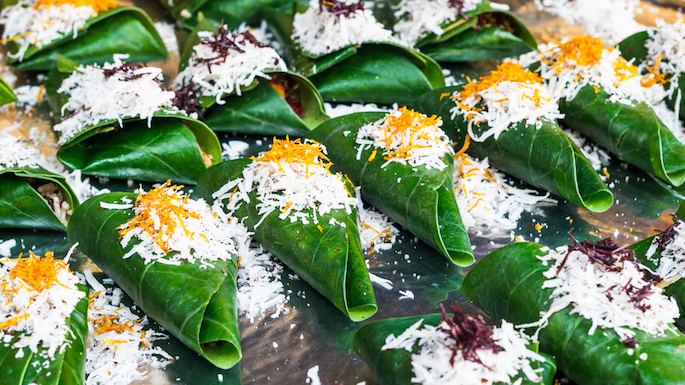
The spit from chewing betel nuts, known as "buai pekpek" in Papua New Guinea, is often considered an eyesore. Because of this, many places have banned selling and chewing "buai".
Chuski paan
Effects on health
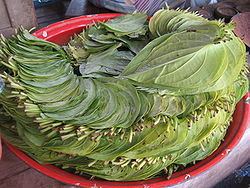
The International Agency for Research on Cancer (IARC) and the World Health Organization (WHO) accept the scientific evidence that chewing betel quids and areca nut is carcinogenic to humans. The main carcinogenic factor is believed to be areca nut. A recent study found that areca-nut paan with and without tobacco increased oral cancer risk by 9.9 and 8.4 times, respectively.
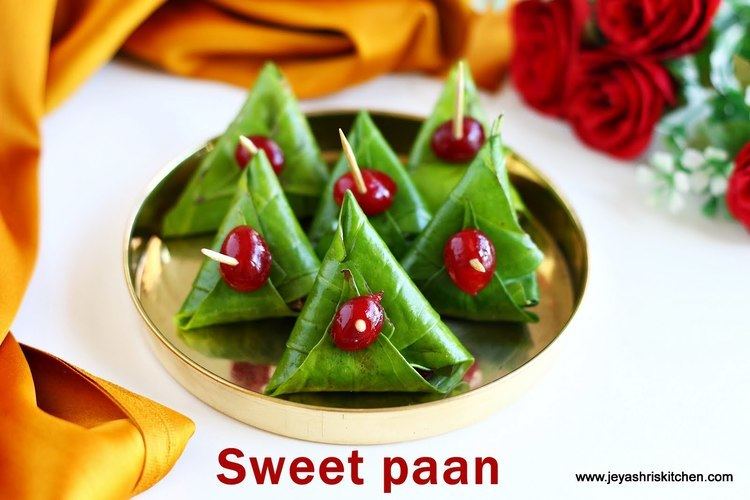
In one study (c. 1985), scientists linked malignant tumours to the site of skin or subcutaneous administration of aqueous extracts of paan in mice. In hamsters, forestomach carcinomas occurred after painting the cheek-pouch mucosa with aqueous extracts or implantation of a wax pellet containing powdered paan with tobacco into the cheek pouch; carcinomas occurred in the cheek pouch following implantation of the wax pellets. In human populations, they reported observing elevated frequencies of micronucleated cells in buccal mucosa of people who chew betel quid in the Philippines and India. The scientists also found that the proportion of micronucleated exfoliated cells is related to the site within the oral cavity where the paan is kept habitually and to the number of betel quids chewed per day. In related studies, the scientists reported that oral leukoplakia shows a strong association with habits of paan chewing in India. Some follow-up studies have shown malignant transformation of a proportion of leukoplakias. Oral submucous fibrosis and lichen planus, which are generally accepted to be precancerous conditions, appear to be related to the habit of chewing paan.
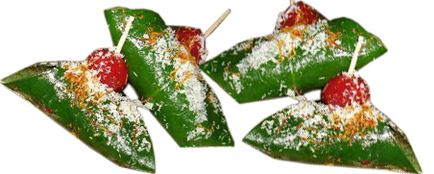
In a study conducted in Taiwan, scientists reported the extent of cancer risks of betel quid (paan) chewing beyond oral cancer, even when tobacco was absent. In addition to oral cancer, significant increases were seen among chewers for cancer of the oesophagus, liver, pancreas, larynx, lung, and all cancer. Chewing and smoking, as combined by most betel chewers, interacted synergistically and was responsible for half of all cancer deaths in this group. Chewing betel leaf quid and smoking, the scientists claimed, shortened the life span by nearly six years.
A Lancet Oncology publication claims that paan masala may cause tumours in different parts of the body and not just the oral cavity as previously thought.
In a study conducted in Sri Lanka, scientists found high prevalence of oral potentially malignant disorders in rural Sri Lankan populations. After screening for various causes, the scientists reported paan chewing to be the major risk factor, with or without tobacco.
In October 2009, 30 scientists from 10 countries met at the International Agency for Research on Cancer (IARC), a World Health Organization sponsored group, to reassess the carcinogenicity of various agents including areca nut, a common additive in paan. They reported there is sufficient evidence that paan chewing, even without tobacco, leads to tumours in the oral cavity and oesophagus, and that paan with added tobacco is a carcinogen to the oral cavity, pharynx and oesophagus.
Effects of chewing paan during pregnancy
Scientific teams from Taiwan, Malaysia and Papua New Guinea have reported that women who chew areca nut formulations, such as paan, during pregnancy significantly increase adverse outcomes for the baby. The effects were similar to those reported for women who consume alcohol or tobacco during pregnancy. Lower birth weights, reduced birth length and early term were found to be significantly higher.
Culture
Chewing the mixture of areca nut and betel leaf is a tradition, custom or ritual which dates back thousands of years from India to the Pacific. Ibn Battuta describes this practice as follows: "The betel is a tree which is cultivated in the same manner as the grape-vine; ... The betel has no fruit and is grown only for the sake of its leaves ... The manner of its use is that before eating it one takes areca nut; this is like a nutmeg but is broken up until it is reduced to small pellets, and one places these in his mouth and chews them. Then he takes the leaves of betel, puts a little chalk on them, and masticates them along with the betel." Since the introduction of tobacco from the Western Hemisphere to the Eastern Hemisphere, it has been an optional addition to paan.
Paan chewing constitutes an important and popular cultural activity in many Asian and Oceanic countries, including Bangladesh, Myanmar, Cambodia, the Solomon Islands, Thailand, the Philippines, Laos, and Vietnam. It is not known how and when the lime paste, areca nut and the betel leaf were married together as one drug. Archaeological evidence from Thailand, Indonesia and the Philippines suggests they have been used in tandem for four thousand years or more.
Paan is a ubiquitous sight in many parts of South and Southeast Asia. It is known as glory in Urdu, beeda in Hindi and vetrrilai or thambulum in Tamil, thambula in Kannada, killi or tambulam in (Telugu), sireh (in Malay language), sirih (in Indonesian), suruh (in Javanese), mark (ໝາກ) in Lao, bulath in Sinhalese, buai in Tok Pisin, and foah (in Dhivehi). In urban areas, chewing paan is generally considered a nuisance because some chewers spit the paan out in public areas – compare chewing gum ban in Singapore and smoking ban. The red stain generated by the combination of ingredients when chewed are known to make a colourful stain on the ground. This is becoming an unwanted eyesore in Indian cities such as Mumbai, although many see it as an integral part of Indian culture. This is also common in some of the Persian Gulf countries, such as the UAE and Qatar, where many Indians live. Recently, the Dubai government has banned the import and sale of paan and the like.
According to traditional Ayurvedic medicine, chewing betel leaf is a remedy against bad breath (halitosis), but it can possibly lead to oral cancer.
India
In a 16th-century cookbook, Nimmatnama-i Nasiruddin-Shahi, describes Ghiyas-ud-din Khalji, the Sultan of Mandu (r. 1469–1500), watches as tender betel leaves of the finest quality are spread out and rosewater is sprinkled on them, while saffron is also added. An elaborate betel chew or paan would contain fragrant spices and rose preserves with chopped areca nuts.
It is a tradition in South India and nearby regions to give two Betel leaves, areca nut (pieces or whole) and Coconut to the guests (both male and female) at any auspicious occasion. Even on a regular day it is the tradition to give a married woman, who visits the house, two Betel leaves, areca nut and coconut or some fruits along with a string of threaded flowers. This is referred to as tambolam.
Betel leaf used to make paan is produced in different parts of India. Some states that produce betel leaf for paan include West Bengal, Bihar, Assam, Andhra Pradesh, Uttar Pradesh. In West Bengal two types of betel leaves are produced. These are "Bangala Patta (Country Leaf)" and Mitha Patta (Sweet Leaf)". In West Bengal, Bangla patta is produced mainly in district of Dinajpur, Malda, Jalpaiguri, and Nadia. Mitha patta is produced in places such as Midnapur and South 24 Parganas.
The skilled paan maker is known as a paanwala in North India. In other parts, paanwalas are also known as panwaris or panwadis. At North India, there is a tradition to chew paan after Deepawali puja for blessings.
Furthermore, the use of paan is also prevalent in one of India's most populous states, the state of the Punjab. So much so that shops selling paan legally have sprung up in western cities such as Toronto, London, and Vancouver to name a few due to the large number of people of Punjabi descent living in those regions.
In the Indian state of Maharashtra the paan culture is widely criticised due to the cleanliness problems created by people who spit in public places. In Mumbai, there have been attempts to put pictures of Hindu gods in places (walls, etc.) where people commonly tend to spit, but success has been limited. One of the great Marathi artists P L Deshpande wrote a comic story on the subject of paanwala (paan vendor), and performed a televised reading session on Doordarshan during the 1980s in his unique style.
Paan is losing its appeal to farmers because of falling demand. Consumers prefer chewing tobacco formulations such as gutka over paan. Higher costs, water scarcity and unpredictable weather have made betel gardens less lucrative.
Indonesia and Malaysia
Bersirih, nyirih or menginang is a Malay-Indonesian tradition of chewing materials such as nut, betel, gambier, tobacco, clove and limestone. Menginang tradition or chewing betel nut is widespread among Indonesian ethnic groups, especially among Javanese, Balinese and Malay, and it dates back to more than 3000 years. Records of travelers from China showed that betel and areca had been consumed since the 2nd century BCE.
In Malay archipelago, the menginang or betel nut chewing has become a revered activity in local tradition; as it has become a ceremoniously conducted gesture to honor a guest. A complete and elaborate set of sirih pinang equipments is called Tepak Sirih, Pekinangan or Cerana. It is made of wooden lacquerware, brass or silverwares and consists of combol (containers), bekas sirih (leaf container), kacip (press-knife to cut areca nut), gobek (small pestle and mortar), and ketur (spit container). It was said that Sirih Pinang has become a symbol of Malay culture.
The Malay oral tradition uses phrases such as "Betel door opener home", "Betel door opener heart". Menginang is used at many formal occasions such as marriages, births, deaths, and healings. Numbers of Malay traditional dances — such as South Sumatran Tanggai dance, are in fact describing the dancers bringing cerana or tepak sirih equipment and ceremoniously presenting an offering of betel nut to the revered guest.
Philippines
Paan has been part of the indigenous culture in the Philippines. Known mainly as tepak sirih in Malay, it is also commonly and simply referred to as ngangà in Tagalog and mama or maman in Ilokano. Ngangà literally means "to chew/gnaw". Nowadays, it is mostly popular among the inhabitants of the Cordilleras, among the Lumads of Mindanao, and among lowland barrio folks elsewhere in the Philippines.
Myanmar
Kwun-ya (ကွမ်းယာ) is the word for paan in Myanmar, formerly Burma, where the most common configuration for chewing is a betel vine leaf (Piper betel), areca nut (from Areca catechu), slaked lime (calcium hydroxide) and some aroma, although many betel chewers also use tobacco.
Betel chewing has very long tradition in Burma, having been practised since before the beginning of recorded history. Until the 1960s, both men and women loved it and every household used to have a special lacquerware box for paan, called kun-it (ကွမ်းအစ်), which would be offered to any visitor together with cheroots to smoke and green tea to drink. The leaves are kept inside the bottom of the box, which looks like a small hat box, but with a top tray for small tins, silver in well-to-do homes, of various other ingredients such as the betel nuts, slaked lime, cutch, anise seed and a nut cutter. The sweet form (acho) is popular with the young, but grownups tend to prefer it with cardamom, cloves and tobacco. Spittoons, therefore, are still ubiquitous, and signs saying "No paan-spitting" are commonplace, as it makes a messy red splodge on floors and walls; many people display betel-stained teeth from the habit. Paan stalls and kiosks used to be run mainly by people of Indian origin in towns and cities. Smokers who want to kick the habit would also use betel nut to wean themselves off tobacco.
Taungoo in Lower Burma is where the best areca palms are grown indicated by the popular expression "like a betel lover taken to Taungoo". Other parts of the country contribute to the best paan according to another saying "Tada-U for the leaves, Ngamyagyi for the tobacco, Taungoo for the nuts, Sagaing for the slaked lime, Pyay for the cutch". Kun, hsay, lahpet (paan, tobacco and pickled tea) are deemed essential items to offer monks and elders particularly in the old days. Young maidens traditionally carry ornamental betel boxes on a stand called kundaung and gilded flowers (pandaung) in a shinbyu (novitiation) procession. Burmese history also mentions an ancient custom of a condemned enemy asking for "a paan and a drink of water" before being executed.
An anecdotal government survey indicated that 40% of men and 20% of women in Myanmar chew betel. An aggregate study of cancer registries (2002 to 2007) at the Yangon and Mandalay General Hospitals, the largest hospitals in the country, found that oral cancer was the 6th most common cancer among males, and 10th among females. Of these oral carcinoma patients, 36% were regular betel quid chewers. University of Dental Medicine, Yangon records from 1985 to 1988 showed that 58.6% of oral carcinoma patients were regular betel chewers.
Since the 1990s, betel chewing has been actively discouraged by successive governments, from the State Law and Order Restoration Council (SLORC) onward, on the grounds of health and tidiness. In April 1995, the Yangon City Development Committee banned betel in Yangon (Rangoon), in anticipation of Visit Myanmar Year 1996, a massive effort to promote the country as a tourist destination. Effective 29 July 2007, betel chewing, along with smoking, has been banned from the Shwedagon Pagoda, the country's most important religious site. In 2010, the Ministry of Education's Department of Basic Education and Burma's Anti-Narcotics Task Force collaborated to prohibit betel shops from operating within 50 metres (160 ft) of any school.
Pakistan
The consumption of paan has long been a very popular cultural tradition throughout Pakistan, especially in Memon and Muhajir households, where numerous paans were consumed throughout the day. In general, though, paan is an occasional delicacy thoroughly enjoyed by many, and almost exclusively bought from street vendors instead of any preparations at home. Pakistan grows a large variety of betel leaf (specifically in the coastal areas of Sindh), although paan is imported in large quantities from India, Bangladesh, Sri Lanka and, recently, Thailand. The paan business is famously handled and run by Memon traders, who migrated from western India, when Pakistan was formed in 1947 (also cite pg 60, of Pakistan, By Samuel Willard Crompton, Charles F. Gritzner).
The culture of chewing paan has also spread in Punjab where a paan shop can be found in almost every street and market. In the famous Anarkali Bazar in Lahore a street called paan gali is dedicated for paan and its ingredients together with other Pakistani products.
Cambodia, Laos and Thailand
The chewing of the product is part of the culture of Cambodia, Laos and Thailand. Cultivation of areca nut palm and betel leaves is common in rural areas of these countries, being a traditional cash crop, and the utensils used for preparation are often treasured. Now, many young people have given up the habit, especially in urban areas, but many, especially older people, still keep to the tradition.
Vietnam
In Vietnam, the areca nut and the betel leaf are such important symbols of love and marriage that in Vietnamese the phrase "matters of betel and areca" (chuyện trầu cau) is synonymous with marriage. Areca nut chewing starts the talk between the groom's parents and the bride's parents about the young couple's marriage. Therefore, the leaves and juices are used ceremonially in Vietnamese weddings.
Bangladesh
In Bangladesh, paan is chewed throughout the country by all classes. Prior to British rule, it was chewed without tobacco. It is offered to the guests and used in festivals irrespective of religion. A mixture called Dhakai paan khili (like a roll) is famous in Bangladesh and the subcontinent.
The sweet pan of the Khasi tribe is famous for its special quality. Paan is also used in Hindu puja and wedding festivals and to visit relatives. It has become a ritual, tradition and culture of Bangladeshi society. Adult women gather with pandani along with friends and relatives in leisure time.
Nepal
Paan is chewed mainly by Madheshis, although migrants in Terai have also taken up chewing paan in recent times. Throughout Terai, paan is as common as anywhere in northern India. There is some local production, generally not commercial, but most leaves are imported from India. Although not as ubiquitous as in the Terai, most residents of Kathmandu occasionally enjoy paan. A sweet version of paan called meetha paan is popular amongst many who do not like the strong taste of plain (sada) paan. Some parents allow their children to consume meetha paan because it is tobacco-free.
Taiwan
In Taiwan betel quid is sold from roadside kiosks, often by the so-called betelnut beauties (Hokkien "pin-nn̂g se-si", Mandarin "bīnláng xīshī", 檳榔西施) — scantily-clad girls selling a quid preparation of betel leaf, betel nuts, tobacco and lime. It is a controversial business, with critics questioning entrapment, exploitation, health, class and culture.
